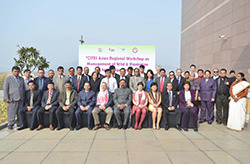Sustaining agarwood
22 January 2015

Opening day of the “ITTO-CITES Asian regional workshop on management of wild and plantation sourcer of agarwood”. Photo: K.Ishii, ITTO
Agarwood is the aromatic wood produced by a fungal infection of certain tree species, mainly in the genera Aquilaria and Gyrinops. The wood is highly sought-after for incense and handicrafts, with high-quality, wild-grown products selling for up to US$2 million per kilogram. Due to the high demand and resultant excessive harvesting, Aquilaria malaccensis, the dominant agarwood-producing species, was listed in Appendix II of the Convention on International Trade in Endangered Species of Wild Fauna and Flora (CITES) in 1995, and most other agarwood-producing species are also now listed in Appendix II.
The workshop, which was convened jointly by ITTO and CITES and hosted by India’s Ministry of Environment, Forests and Climate Change, focused on trends in the management and trade of wild and plantation-sourced agarwood. The report of the workshop, including all presentations, will be posted on the ITTO–CITES Programme website (http://www.itto.int/cites_programme/).